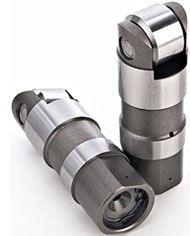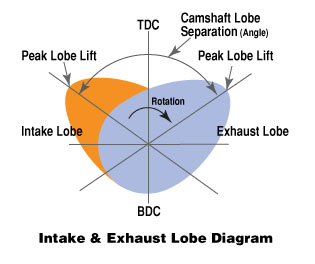You have no items in your shopping cart.
Understanding Camshaft Fundamentals
Camshaft Types
 There are two most common types of camshafts: Flat Tappet and Roller Cams. Flat Tappet (Lifters) are in most V8's and literally have what looks like a flat bottom where the cam lobe contacts the tappet (lifter). Lifters are not actually flat on the contact surface. They do have a slight curve, but it's hard to see. Roller Cams use a lifter with a roller on it. The roller cam looks like the flat tappet cam, but the cam lobes are very different. Roller cams have fatter lobes because of the way the cam lobe contacts the lifter. Roller lifters reduce friction, increase RPM potential and allow higher valve spring pressures to be used. Flat tappet camshafts can only withstand so much valve spring pressure pushing the lifter against the cam lobe.
There are two most common types of camshafts: Flat Tappet and Roller Cams. Flat Tappet (Lifters) are in most V8's and literally have what looks like a flat bottom where the cam lobe contacts the tappet (lifter). Lifters are not actually flat on the contact surface. They do have a slight curve, but it's hard to see. Roller Cams use a lifter with a roller on it. The roller cam looks like the flat tappet cam, but the cam lobes are very different. Roller cams have fatter lobes because of the way the cam lobe contacts the lifter. Roller lifters reduce friction, increase RPM potential and allow higher valve spring pressures to be used. Flat tappet camshafts can only withstand so much valve spring pressure pushing the lifter against the cam lobe.  As you increase valve spring pressure on a flat tappet cam, you increase wear on the cam lobe and the cam contact face of the lifter. This is a limiting factor when compared to a roller setup. To build big horsepower you need to have a cam with a lot of lift to open those valves wide. A lot of cam lift will require a higher pressure valve spring, giving the roller cam/lifter the advantage over flat tappet cams for building higher horsepower engines.
As you increase valve spring pressure on a flat tappet cam, you increase wear on the cam lobe and the cam contact face of the lifter. This is a limiting factor when compared to a roller setup. To build big horsepower you need to have a cam with a lot of lift to open those valves wide. A lot of cam lift will require a higher pressure valve spring, giving the roller cam/lifter the advantage over flat tappet cams for building higher horsepower engines.
Camshaft Lift
It's important to be aware of a few ways camshaft lift is talked about. Cam lobe lift, also called Gross Lift, is the distance a cam moves a lifter/tappet. Because a rocker arm multiplies the movement of the tappet, valve lift is not the same as cam lobe lift. A 1.5:1 rocker arm ratio takes .4 inches of lobe lift and moves the valve 1.5 times the lobe lift. For example: A cam with a lobe lift of .4 inches will move a valve .6 inches with a 1.5:1 rocker arm ratio (1.5 x .4). A different ratio rocker arm will change the valve lift, but not the lobe lift of a cam. You can therefore increase valve lift by using an increased rocker arm ratio. More cam lift means the valve will open further. Increasing cam lift will allow more air or exhaust to move through an engine. If you plan on upgrading your cam to increase lift, you must be sure your valve springs are capable of handling a cam with increased lift. Piston to valve clearance can also become an issue. Verify that you will have enough clearance before you buy a new cam.
Camshaft Duration
Camshaft Duration is the measurement of the time one valve begins to open until it finishes closing. Duration is measured in degrees of crankshaft rotation, not camshaft rotation. You'll see duration specifications at .050 inches. Cam manufacturers agreed on a standard to measure duration so all cams are measured the same way. The idea is to measure duration starting at .050 inches of tappet (lifter) movement. As the lobe lifts the tappet up, when the tappet moves .050 inches, the duration is measured from that point.
Intake Duration at .050 inch Lift - The number of degrees the crankshaft moves while the intake valve is open. Cam manufacturers agreed to measure and give camshaft duration based on the lifter moving .050 inches. This made duration numbers easier to compare between different cam manufacturers.
Exhaust Duration at .050 inch Lift - The number of degrees the crankshaft moves while the exhaust valve is open. Cam manufacturers agreed to measure and give camshaft duration based on the lifter moving .050 inches. This made duration numbers easier to compare between the different cam manufacturers.
Camshaft Lobe Separation (in degrees)
 Camshaft lobes on standard V8's, like the small block Chevy, are arranged in pairs: One intake lobe, one exhaust lobe. Those pairs of lobes are phased to each other. Cam lobe separation is the angle in degrees between maximum lift of a pair of cam lobes. To picture cam lobe separation a little better, look at the end of a traditional V8 camshaft. Draw a line through the center of the cam out through the point of maximum lift on each cam lobe on a pair of lobes. You'll usually find the measurement between 104 and 115 degrees. It's important to note that Lobe Separation describes how the intake valve reacts in relationship to the exhaust valve in the same cylinder. Where cam lift and duration describe the effect of each lobe on a valve. Cam Lobe Separation is an important performance characteristic because it times the intake and exhaust valves. If the Lobe Separation angle was 0 degrees, both intake and exhaust valves would be opened and closed at the same time. That obviously won't work, but it may help us understand what happens as the separation angle decreases or increases on a cam.
Camshaft lobes on standard V8's, like the small block Chevy, are arranged in pairs: One intake lobe, one exhaust lobe. Those pairs of lobes are phased to each other. Cam lobe separation is the angle in degrees between maximum lift of a pair of cam lobes. To picture cam lobe separation a little better, look at the end of a traditional V8 camshaft. Draw a line through the center of the cam out through the point of maximum lift on each cam lobe on a pair of lobes. You'll usually find the measurement between 104 and 115 degrees. It's important to note that Lobe Separation describes how the intake valve reacts in relationship to the exhaust valve in the same cylinder. Where cam lift and duration describe the effect of each lobe on a valve. Cam Lobe Separation is an important performance characteristic because it times the intake and exhaust valves. If the Lobe Separation angle was 0 degrees, both intake and exhaust valves would be opened and closed at the same time. That obviously won't work, but it may help us understand what happens as the separation angle decreases or increases on a cam.
If the Lobe Separation Angle is narrower: As a cam turns, one valve opens. As the cam continues to turn, that valve starts to close. Since the angle is narrower, the 2nd valve in the pair is beginning to open before the first one is closed. How far the first valve is open when the 2nd valve begins to open depends on the Cam Lobe Separation. (The shape of the cam lobe also effects this.) A narrow angle will increase cylinder pressure, make an engine idle worse and reduce idle vacuum. Cylinder pressure increases because after the exhaust stroke, the piston is pulling air into the cylinder. If the intake valve opens earlier, more air can be sucked into the cylinder.
If the Lobe Separation is Wider: As a cam turns, one valve opens. As the cam continues to turn, that valve starts to close. With a wider angle, the 2nd valve in the pair is starting to open later. With the right angle, you could time the first valve to be closed before the second one opens. With a wider separation angle, cylinder pressure is reduced, idle is smoother and idle vacuum is better.
Which Camshaft is best for me?
Camshafts are very complex mechanisms that entail a myriad of numbers, and there are millions of grinds out there. Luckily, most camshaft manufacturers have made it a much easier for the enthuthiast to select a camshaft.
Cam Rule #1: If you are having your engine assembled by a professional engine builder, involve their opinions and knowledge in the selection. Nothing beats experience.
Cam Rule #2: The most common mistake in a cam selection is to select a cam that is too big, thus hurting performance. If you are deciding between two camshafts, typically the smaller grind is the wise choice.

